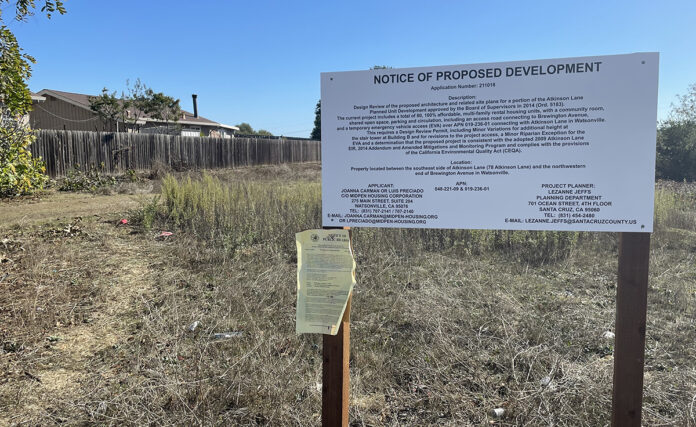A weekly guide to what’s happening.
ARTS AND MUSIC
A CHRISTMAS STORY, THE MUSICAL! Christian Youth Theater (CYT) Santa Cruz is back with a captivating live performance of “A Christmas Story, The Musical.” Based on the hilarious and heartwarming movie classic that delights audiences around the world every Christmas season, this high-energy musical follows the charming, determined nine-year-old Ralphie Parker in his quest for the holy grail of Christmas gifts: an Official Red Ryder Carbine-action 200-shot Range Model Air Rifle. With dynamic music by Pasek and Paul (writers of “The Greatest Showman,” “Dear Evan Hansen” and more) and a riveting story by Joseph Robinette, this show is truly a magical treat for the whole family. CYT’s spectacular production includes every iconic scene, from the flagpole, to the leg lamp, to the pink bunny suit—this musical has it all! Kick off your glorious holiday season with CYT Santa Cruz at “A Christmas Story, The Musical,” coming to the new Performing Arts Chapel at Monte Vista Christian School November 12-14. Details and tickets available now at cytsantacruz.org. Friday, Nov. 12, 7pm. Monte Vista Performing Arts, 2 School Way, Watsonville.
CHARLEY’S AUNT Brandon Thomas’ side-splitting farce, Charley’s Aunt is playing now at Cabrillo College’s Crocker Theatre’s Blackbox Stage. Ela Delahy (played by Nichole Langmead) shares secrets with Lord Fancourt Babberley (Nathan Woodward) while Donna Lucia D’Alvadorez (Shannon Marie McDonough) eavesdrops. Performances begin on November 5th and run weekends thru November 21st. More info and tickets available thru www.cabrillovapa.com or call 831-479-6154. Rumor has it: they will sell out fast!
CELTIC TEEN BAND PROGRAM Teenage musicians ages 12-19 play in an ensemble, developing musicianship, flexibility, and musical creativity. Participants work on music from Ireland, Scotland, Brittany, Norway, Sweden, and the United States, in addition to modern and more quirky pieces. Instruments welcomed include fiddle, viola, flute, tin whistle, pipes, cello, upright bass, guitar, mandolin, banjo, dulcimer, autoharp, ukulele, Celtic harp, accordion and percussion. Students must have at least two years experience on their instrument, and must be able to read sheet music and chord symbols. The group meets twice a month Wednesday afternoons from 3:30-5pm at the London Nelson Center with fiddle teacher John Weed. Cost is free-$10 per session on a sliding scale. Potential students are welcome to come for a session and see if they like it—no obligation! More information and registration at CommunityMusicSchool.org/teenband. Wednesday, Nov. 10, 3:30pm. Louden Nelson Community Center, 301 Center St., Santa Cruz.
HOLIDAY OPEN HOUSE Holiday Open House at Stewart’s Floral. Celebrate the beginning of a joyous holiday season. Decorated Christmas trees, holiday gifts and home decor items. Featuring Mark Roberts Fairies. There will be refreshments, too. Call for more information: 831-479-0999. Saturday, Nov. 13, 10am-5pm. Sunday, Nov. 14, 10am-5pm. Stewart’s Floral, 1658 Soquel Drive #A, Santa Cruz.
LA SELVA BEACH BRANCH LIBRARY OPENING CELEBRATION AND HOLIDAY CRAFT FAIR The La Selva Beach Branch Library will host activities for adults and kids indoors and on the patio. Teenage magician James Chan will walk among the crowd performing magic and card tricks from noon-1pm and 1:30-2:30pm. The Craft Fair will feature 26 vendors of fine arts and crafts. The Friends of the LSB Library will host a book sale inside the Clubhouse. LSB Community Emergency Response Team (CERT) will host a bake sale and prize raffle to help fund community emergency response needs. Come and enjoy live music in the courtyard and great eats from local food trucks. Saturday, Nov. 13, 10am-4pm. La Selva Beach Branch Library, 316 Estrella Ave., La Selva Beach.
MOUNTAINFILM ON TOUR SANTA CRUZ Mountainfilm on Tour brings a selection of culturally rich, adventure-packed and incredibly inspiring documentary films curated from the Mountainfilm festival in Telluride, Colorado. The tour will soon visit Santa Cruz with films that explore themes connected to Mountainfilm’s mission of using the power of film, art and ideas to inspire audiences to create a better world. The Rio Theatre has been organizing Mountainfilm on Tour for several years and has been working with local schools to host Mountainfilm in Education to area students. Mountainfilm is a documentary film festival that showcases stories about environmental, cultural, climbing, political and social justice issues. Mountainfilm is held every Memorial Day weekend in Telluride, Colorado. Along with exceptional documentaries, the festival goes beyond the film medium by bringing together world-class athletes, change makers and visionary artists for a multi-dimensional celebration of indomitable spirit. We will be serving Sierra Nevada Sufferfest beer with a portion of proceeds benefiting Second Harvest Food Bank. Please check the Rio Theatre Covid-19 protocols before purchasing tickets; riotheatre.com. Saturday, Nov. 13, 7pm. Rio Theatre, 1205 Soquel Ave., Santa Cruz.
OUTDOOR FILM SCREENING AT GREATER PURPOSE BREWERY: UNITED AGAINST HATE As part of the national United Against Hate Week movement, SCPL has partnered with Santa Cruz County United for Safe and Inclusive Communities to bring community members together through films, conversations and actionable opportunities to prevent hate violence and to build safe, inclusive environments where everyone can participate in public life. Join us at Greater Purpose Brewery for a free outdoor screening and engaging discussion of Not in Our Town short films. This curated list of films feature how dedicated people and community groups stood, spoke and acted against hate when hate crimes were committed in their towns. A facilitated discussion will follow each film to explore what, where, why and how Santa Cruz County communities can unite against hate. Special thanks to Greater Purpose Brewery for hosting this event in their outdoor beer garden and making provisions for us to move inside in case of inclement weather. Food and beer will be available for purchase. Proof of vaccination or a mask is required for entry into the taproom. Cheers! Sunday, Nov. 14, 6pm. East Cliff Brewing Co., 21517 E Cliff Drive, Santa Cruz.
COMMUNITY
COMMUNITY PILATES MAT CLASS Come build strength with us. This very popular in-person community Pilates Mat Class in the big auditorium at Temple Beth El in Aptos is in session once again. Please bring your own mat, small Pilates ball and theraband if you have one. You must be vaccinated for this indoor class. Suggested donation of $10/class is welcome. Thursday, Nov. 11, 10am. Tuesday, Nov. 16, 10am. Temple Beth El, 3055 Porter Gulch Road, Aptos.
CUÉNTAME UN CUENTO Acompáñanos para una hora de cuentos, actividades y canciones en español. Este programa es para niños de 0-8 y sus familias. La hora será miércoles a las 4:30pm. Nos reuniremos en el porche exterior. Cuéntame un Cuento se llevará a cabo en Capitola durante el período de construcción de Live Oak. En caso de mal clima, se cancelará la hora de cuentos. Join us for Spanish Storytime, activities, and music! This program is best suited for kids ages 0-8 and their families. Storytime takes place on Wednesday at 4:30pm. We will meet on the outside porch. Storytime will take place at Capitola during Live Oak’s construction period. In the event of bad weather, storytime will be cancelled. Wednesday, Nov. 10, 4:30pm. Capitola Library A Santa Cruz City County Public Library Branch, 2005 Wharf Road, Capitola.
DOWNTOWN SANTA CRUZ ANTIQUE FAIRE The Santa Cruz Antique Faire is on the second Sunday of every month. Vendors offer an eclectic blend of antiques and unique items, vintage clothing, collectibles, LP’s, clothing, furniture, memorabilia, home decor and more! Sunday, Nov. 14, 9am-5pm. Downtown Santa Cruz Antique Faire, Lincoln St. between Pacific and Cedar Sts, Santa Cruz.
FELTON TODDLER TIME Join Librarian Julie on our beautiful Felton patio for Toddler Time. Toddler Time is a weekly early literacy program for families with children ages 0-3 years old. Music, movement, stories, fingerplays, rhymes, and songs are a fun way for your child to learn. Let’s play and learn together! Make sure to bring something to sit on. We ask that adults please wear a mask. Repeats weekly. Wednesday, Nov. 10, 11am. Felton Branch Library, 6121 Gushee St., Felton.
GREY BEARS BROWN BAG LINE Grey Bears are looking for help with their brown bag production line on Thursday and Friday mornings. Volunteers will receive breakfast and a bag of food if wanted. Be at the warehouse with a mask and gloves at 7am. Call ahead for more information: 831-479-1055, greybears.org. Thursday, Nov. 11, 7am. California Grey Bears, 2710 Chanticleer Ave., Santa Cruz.
KNITTING AT THE FELTON LIBRARY Join us every Monday afternoon at the Felton Branch for a knitting party. All you need to do is bring some yarn and knitting needles. All ages are welcome. Monday, Nov. 15, 12:30pm. Felton Branch Library, 6121 Gushee St., Felton.
LA SELVA BEACH PRESCHOOL STORYTIME Join us for a fun interactive storytime. We’ll read books, sing songs and use rhythm and movement. This event is suitable for children ages 3-6 years. There will be an arts and crafts project to take home. This event will be held outside on the back patio. Please bring something to sit on and dress for the weather. Masks will be required. Repeats weekly. Tuesday, Nov. 16, 11am. La Selva Beach Branch Library, 316 Estrella Ave., La Selva Beach.
PRESCHOOL STORYTIME IN THE SECRET GARDEN Join us in the Secret Garden in Abbott Square at the MAH for storytime! We’ll share stories, songs and rhymes in a safe environment! This 30-40 minute program is intended for children aged 2-6. Do it yourself craft kits will be provided every week. Every other week we will feature STEM-related stories and concepts. Tuesday, Nov. 16, 11am. Abbott Square, 118 Cooper St., Santa Cruz.
R.E.A.D.: REACH EVERY AMAZING DETAIL R.E.A.D. is one-on-one reading comprehension instruction for readers second-12th grade. Instructors are California credentialed teachers. Sessions are 25 minutes long. By appointment only. Contact SCPL Telephone Information if you have any questions: 831-427-7713. Wednesday, Nov. 10, 3pm. Capitola Library A Santa Cruz City County Public Library Branch, 2005 Wharf Road, Capitola.
R.E.A.D.: REACH EVERY AMAZING DETAIL @ DOWNTOWN R.E.A.D. is one-on-one reading comprehension instruction for readers second-12th grade. Instructors are California credentialed teachers. Sessions are 25 minutes long. By appointment only. Contact SCPL Telephone Information if you have any questions: 831-427-7713. Thursday, Nov. 11, 3pm. Santa Cruz Public Libraries Downtown Branch, 240 Church St., Santa Cruz.
R.E.A.D.: REACH EVERY AMAZING DETAIL @ LA SELVA BEACH R.E.A.D. is one-on-one reading comprehension instruction for readers second-12th grade. Instructors are California credentialed teachers. Sessions are 25 minutes long. By appointment only. Contact SCPL Telephone Information if you have any questions: 831-427-7713. Wednesday, Nov. 10, 3pm. La Selva Beach Branch Library, 316 Estrella Ave., La Selva Beach.
GROUPS
ENTRE NOSOTRAS GRUPO DE APOYO Entre Nosotras support group for Spanish speaking women with a cancer diagnosis. Meets twice monthly. Registration required, please call Entre Nosotras 831-761-3973. Friday, Nov. 12, 6pm. WomenCARE, 2901 Park Ave., Suite A1, Soquel.
S+LAA MENS’ MEETING Having trouble with compulsive sexual or emotional behavior? Recovery is possible. Our small 12-step group meets Saturday evenings. Enter through the front entrance, go straight down the hallway to the last door on the right. Thursday, Nov. 11, 6pm. Sutter Maternity & Surgery Center, 2900 Chanticleer Ave., Santa Cruz.
WOMENCARE ARM-IN-ARM WomenCARE Arm-in-Arm Cancer support group for women with advanced, recurrent, or metastatic cancer. Meets every Monday, currently on Zoom. Registration is required, call WomenCARE at 831-457-2273. All services are free. For more information visit womencaresantacruz.org. Monday, Nov. 15, 12:30pm. WomenCARE, 2901 Park Ave., Suite A1, Soquel.
WOMENCARE TUESDAY SUPPORT GROUP WomenCARE Tuesday Cancer support group for women newly diagnosed and through their treatment. Meets every Tuesday currently on Zoom. Registration required, call WomenCARE 831-457-2273. Tuesday, Nov. 16, 12:30-2pm. WomenCARE, 2901 Park Ave., Suite A1, Soquel.
WOMENCARE: LAUGHTER YOGA Laughter yoga for women with a cancer diagnosis. Meets every Wednesday, currently via Zoom. Registration is required, please call WomenCARE at 831-457-2273. Wednesday, Nov. 10, 3:30-4:30pm. WomenCARE, 2901 Park Ave., Suite A1, Soquel.
OUTDOOR
CASFS FARMSTAND Organic vegetables, fruit, herbs and flowers are sold weekly at the CASFS Farmstand, starting June 15 and continuing through Nov. 23. Proceeds support experiential education programs at the UCSC Center for Agroecology & Sustainable Food Systems. Friday, Nov. 12, Noon-6pm. Tuesday, Nov. 16, Noon-6pm. Cowell Ranch Historic Hay Barn, Ranch View Road, Santa Cruz.
HISTORIC RANCH GROUND TOUR Discover what life was like a century ago on this innovative dairy ranch. This hour-long tour includes the 1896 water-powered machine shop, barns and other historic buildings. The vehicle day-use fee is $10. For more information, call 831-426-0505. Spaces are limited and early pre-registration is recommended. Attendees are required to self-screen for Covid-19 symptoms when pre-registering. Masks and social distancing are also required at all programs. Saturday, Nov. 13, 1-2pm. Sunday, Nov. 14, 1-2pm. Wilder Ranch State Park, 1401 Coast Road, Santa Cruz.
SUNSET BEACH BOWLS Experience the tranquility, peace and calmness as the ocean waves harmonize with the sound of crystal bowls raising vibration and energy levels. Every Tuesday one hour before sunset at Moran Lake Beach. Call 831-333-6736 for more details. Tuesday, Nov. 16, 6:30-7:30pm. Moran Lake Park & Beach, East Cliff Drive, Santa Cruz.





















